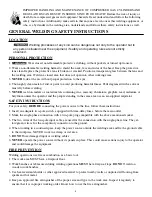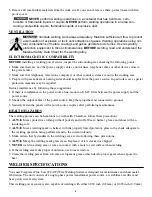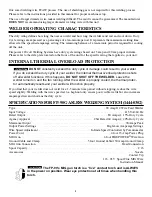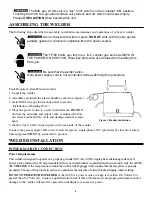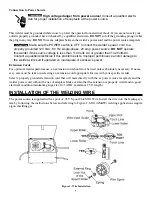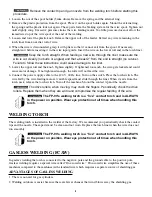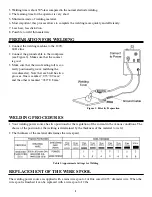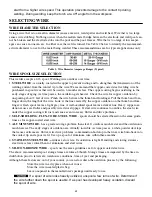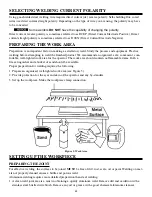
There are two basic types of weld beads: the stringer bead and the weave bead.
1. Form the stringer bead (see Figure 11) by travel-
ing with the line while keeping the wire and
nozzle centered over the weld joint. It is the eas-
iest type of bead to make and is the type you
have used up to this point.
2. Use the weave bead (see Figure 12) when you
want to deposit much wider space than is possi-
ble with a stringer bead. It is made by moving
the gun from side to side. It is best to hesitate
momentarily on each side before weaving back
the other way.
WELDING POSITIONS
There are four basic welding positions: flat, horizontal, vertical and overhead.
1. The flat position (see Figure 13) is the easiest welding position. It is probably the one you have used thus
far. It is best to weld in the flat position when possible since good results are easier to achieve.
2. The horizontal position (see Figure 14) is next in difficulty level. It is performed very much the same as the
flat weld except that angle B (see “Position the Gun to the Workpiece,” page 15) is such that the wire, and
therefore, the arc force is directed more toward the metal above the weld joint. This helps prevent the weld
puddle from running downward while still allowing slow enough travel speed to achieve good penetration.
A good starting point for angle B is about 30º down from being perpendicular to the workpiece.
3. The vertical position (see Figure 15) is the next most difficult position. Pulling the gun from top to bottom is
easier for many people. In some instances, it is difficult to prevent the puddle from running downward.
Pushing the gun from bottom to top may provide better puddle control. It allows slower rates of travel speed to
achieve deeper penetration. When vertical welding, Angle B (see “Position the Gun to the Workpiece,”page 15)
is usually kept at zero. Angle A generally ranges from 45º to 60º to provide better puddle control.
4. The overhead position (see Figure 16) is the most difficult welding position because gravity pulls at the
weld puddle making it drip off the workpiece. Maintain Angle A at 60º (see “Position the Gun to the
Workpiece”), the same as in the flat position. Maintaining this angle reduces the chances of molten metal
17
Figure 11: Stinger Weld Bead
Figure 12: Weave Weld Bead
Figure 13: Flat Position Weld
Figure 14: Horizontal Position Weld
Figure 15: Vertical Position Weld
Figure 16: Overhead Position Weld
Summary of Contents for FP-90
Page 2: ......
Page 27: ...23 Figure 21 FP 90...
Page 29: ...25 Figure 22 FP 90 Wiring Diagram...
Page 30: ...26...

